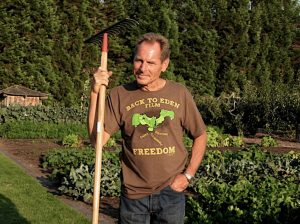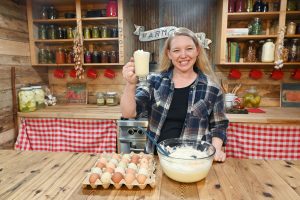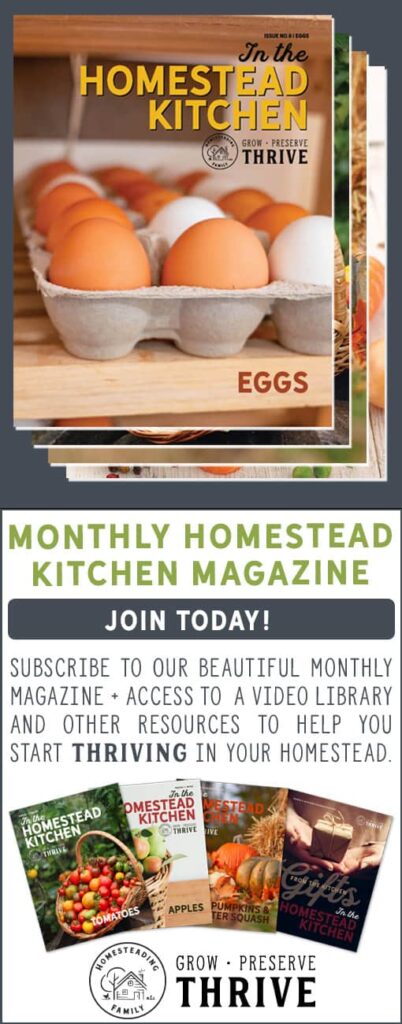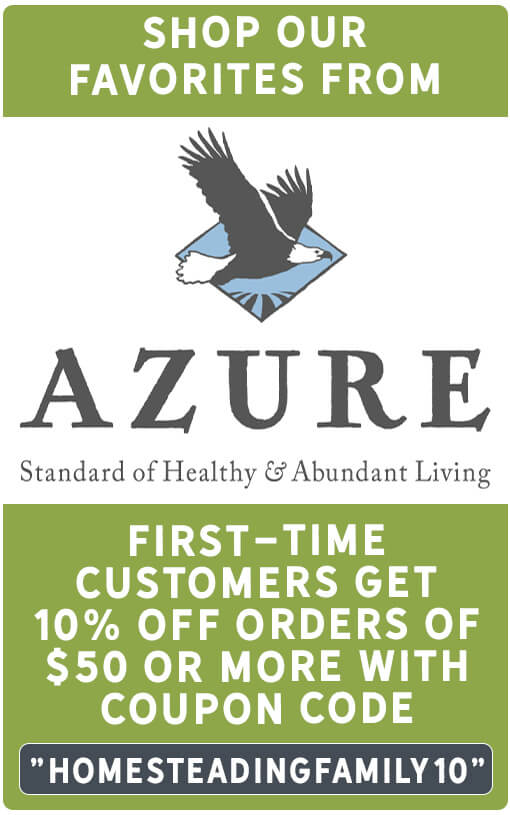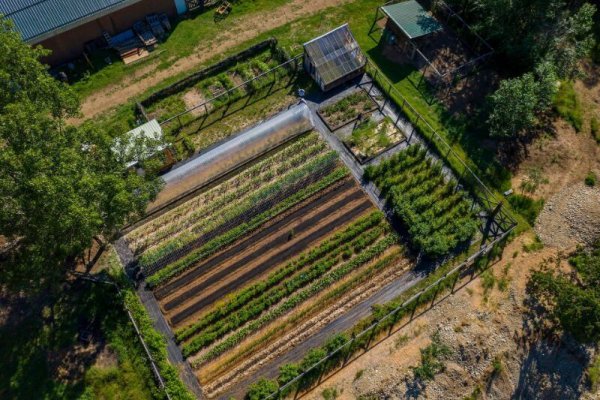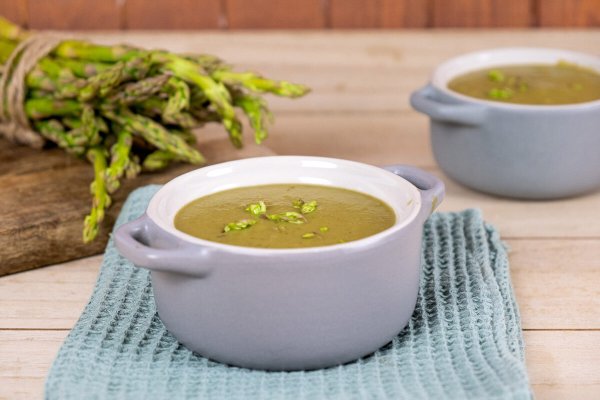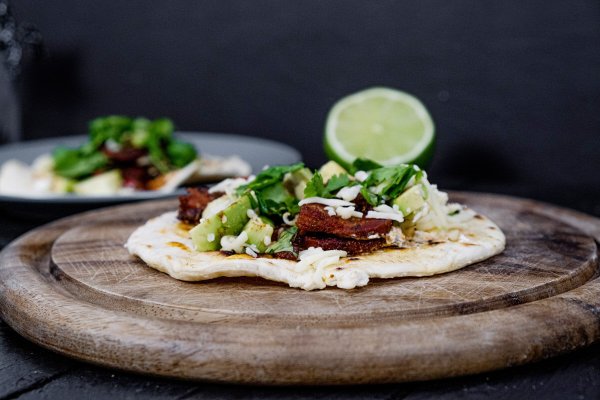If you’re looking to get into dairy animals, raising goats is a great way to get started. But to ensure you’re set up properly to give them the care they need, you need to know a few things first. We’re talking about everything you need to know to keep dairy goats.
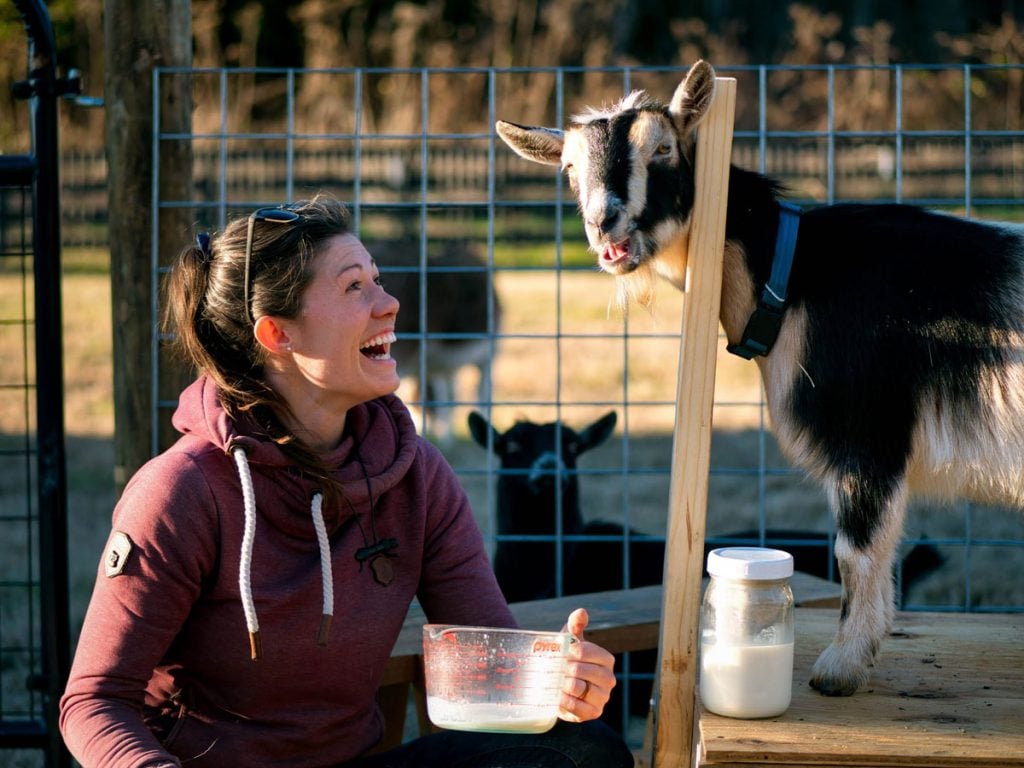
Why Keep Dairy Goats?
Goats are a great entry point for dairy animals, but there are some tricks of the trade you’ll certainly want to know first.
A few years back, Carolyn and I acquired some dairy goats and they only lasted a few days on the farm because they just got into everything. Goats are mischievous animals and we were simply not prepared.
There’s a saying that goes something like this… How do you know if a fence will hold a goat in? If it keeps water in! That’s basically a clever way to say that if a goat wants to get out, it will find a way!
We’re excited to have Anne of All Trades on the Pantry Chat today because she’s been raising dairy goats for many years and knows a thing or two about how to be successful.
Be sure to check out her blog as well as her YouTube channel where she shares many more tips for raising goats including building an easy goat stanchion for milking, trimming goat’s hooves, and even the birth of her one-pound goat, Milk Dud!
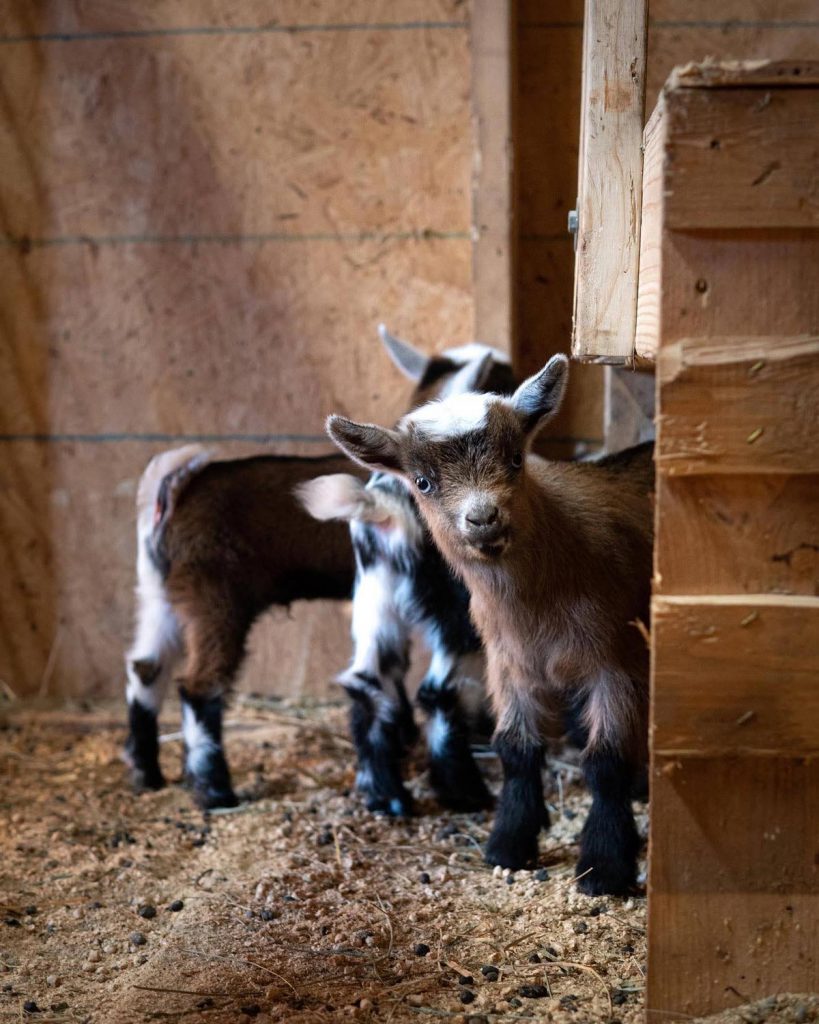
Raising Goats
Can You Raise Just One Goat?
Many people wonder if it’s possible to just raise one dairy goat, but Anne tells us that goats are herd animals and it’s very unkind to just raise one. She recommends you have at least two goats as a minimum.
This doesn’t mean you have to raise two milk goats, but her recommendation would be to raise two goats and have one be in milk production for six months out of the year, then the other goat in milk for the other six months.
Consider Your Space
A Nubian goat is about twice the size of the Nigerian Dwarf goats, so consider your space when considering the breed you would like to start with.
Sometimes there’s a good reason to buy specialty breeds or heritage breeds, but if you’ve never raised goats before, start by considering your accessibility.

Dairy Breeds for Goats
As we list the breeds of dairy goats, keep in mind that when an animal is listed as “mild-tempered” or “high-energy”, even “large” or “small” breed, each animal has its own genetics and personality and you can have a mild-tempered high energy breed, or a high energy mild-tempered breed.
Nigerian Dwarf
Anne raises Nigerian Dwarf Goats which have some of the highest fat content in their milk. They have a 14% butterfat content whereas typical whole milk from the grocery store is 4% butterfat.
Nubian
Nubian goats are slightly larger, so it’s important to consider your space as you’ll want room for at least two goats. Their butterfat content is quite a bit lower, so if you’re wanting the milk for the fat content, you may want to choose a different breed.
Saanen
This is a fairly large breed with a mild temperament. Saanen goat’s milk is among the lower in butterfat, so this is a good breed to choose if you only want the milk for drinking, not soap or cheese-making.
Alpine
Known to be an easier to manage breed, the Alpine goats will be steady producers. They’re a medium-sized breed.
LaMancha
Another goat known for its milk production is the LaMancha. These are friendly goats known to have good temperaments. Their milk also has a lower butterfat content of about 4%.
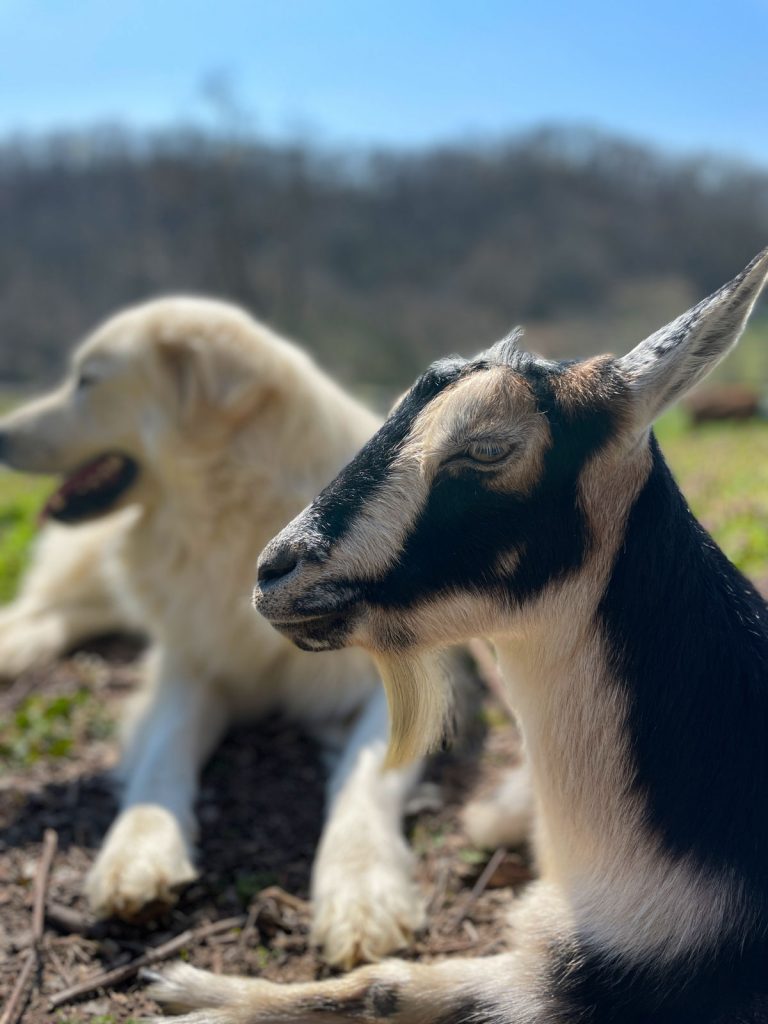
Dual-Purpose Breeds
A dual-purpose breed is a goat that one can raise both for milk production and meat.
Anne prefers Nubian’s when it comes to a dual-purpose goat because you obviously want there to be enough meat on the goat to make raising them worth it.
She does know people who raise Nigerian Dwarf goats that butcher them for their meat and say it’s great meat. But again, there is just not very much of it.
Boer goats are great for meat, so if you’re looking for a good dual-purpose breed, she recommends breeding a Boer and a Nigerian and creating your own mixed breed that will give you the best of both genetics.
Boer goats will also produce milk, it’s just a matter of flavor preference.
Breeding Goats
If you want milk from your goats, you will need to have babies yearly, which means that you will have to consider how you will get them bred. So you will need to consider how you’ll breed them. Will you keep a buck on your property and breed yourself? Do you know someone with a buck you could bring in?
Accessibility is key when it comes to wanting to breed your goats. Which, if you’re wanting to keep your goats in milk, you will need to continue to breed them.
If you don’t have access to a buck, then you may need to learn how to AI (artificially inseminate).
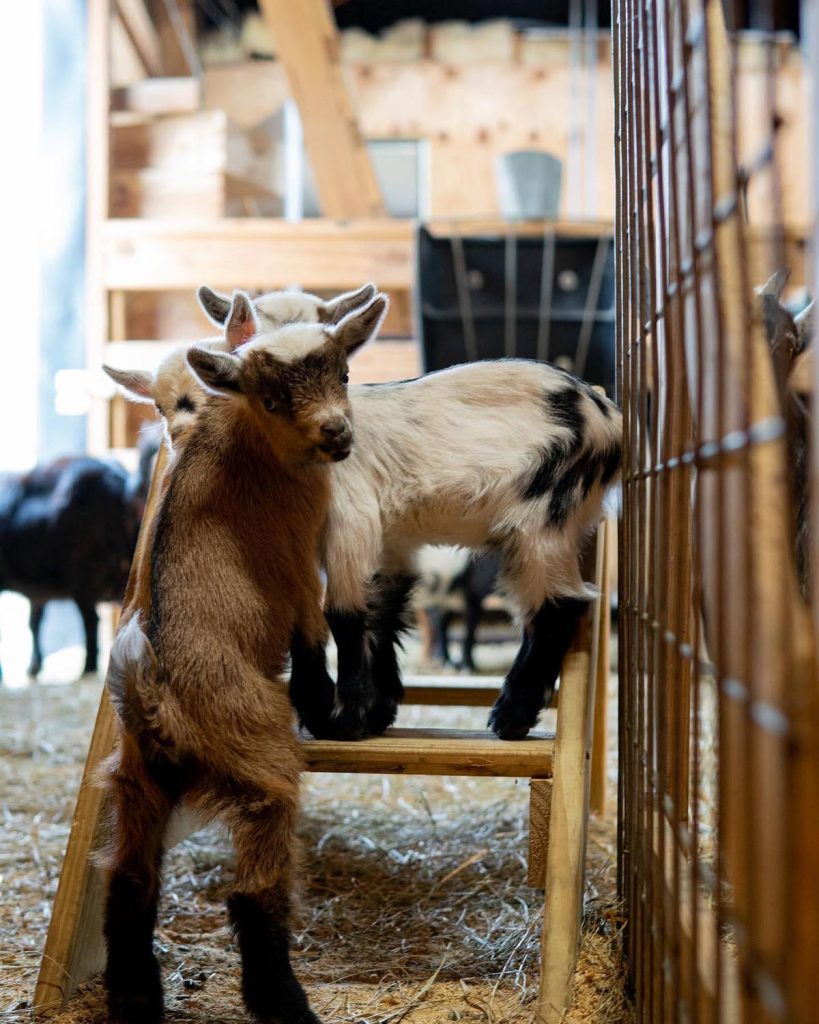
Supplies Needed For Raising Goats
We always encourage people to be adequately prepared when taking on new tasks around the homestead. Learn from our mistakes of jumping in with both feet and learning the hard way. When it comes to goats, it’s much better to be prepared, or else you may end up finding new homes for them as Carolyn and I did!
Here’s Anne’s list of must-have supplies before bringing your goats home to the homestead:
- Food – you want to have good quality food before bringing home your goats.
- Water – access to clean water
- Shelter – at a minimum you’ll need a three-walled shelter. If you live where it’s hot or cold, you may need something a little different.
- Fence – goats are extremely mischievous and will figure out ways to open up gates, jump fences, chew through wires, etc. If there’s trouble to be found, they will find it. If you’re going to invest in any of your supplies, your fencing is the place to spend some extra money. You do not want to cut corners or try to DIY a goat fence because chances are, you’ll end up having to do it the right way in the long run.
- Milking stanchion – when bringing goats home to milk, you’ll need an area to milk them. Most goats won’t simply stand still while you milk, so having a milking stanchion is key. Anne shares how to build a milk goat stanchion out of a pallet here. It doesn’t have to be elaborate or expensive to get the job done well.
Something else to consider, especially if you live in a rural area or move to a rural area, is protection for your goats. They are hunted and stalked by predatory animals and can easily be snatched away by cougars, mountain lions, coyotes, etc. One way Anne keeps her goat herd safe is with Livestock Guardian Dogs.
Goat’s Milk vs. Cow’s Milk
Unfortunately, goat’s milk has gotten a bad wrap because a lot of it can have a very “goaty” flavor. Anne describes it as drinking a glass of chevre cheese. It has a bit of a musky kick to it that doesn’t make it a pleasant glass of milk to drink.
The reason for this is that much of the goat’s milk at the grocery store is old. It takes a while to get from a farm to the grocery store. And as we’ve discussed before, the anatomy of raw milk is that it doesn’t spoil. But it does go through various stages.
The same goes for goat’s milk. It will stay fresh for a week to two weeks depending on your milking practices, but will taste best when it’s fresh, usually within that first week.
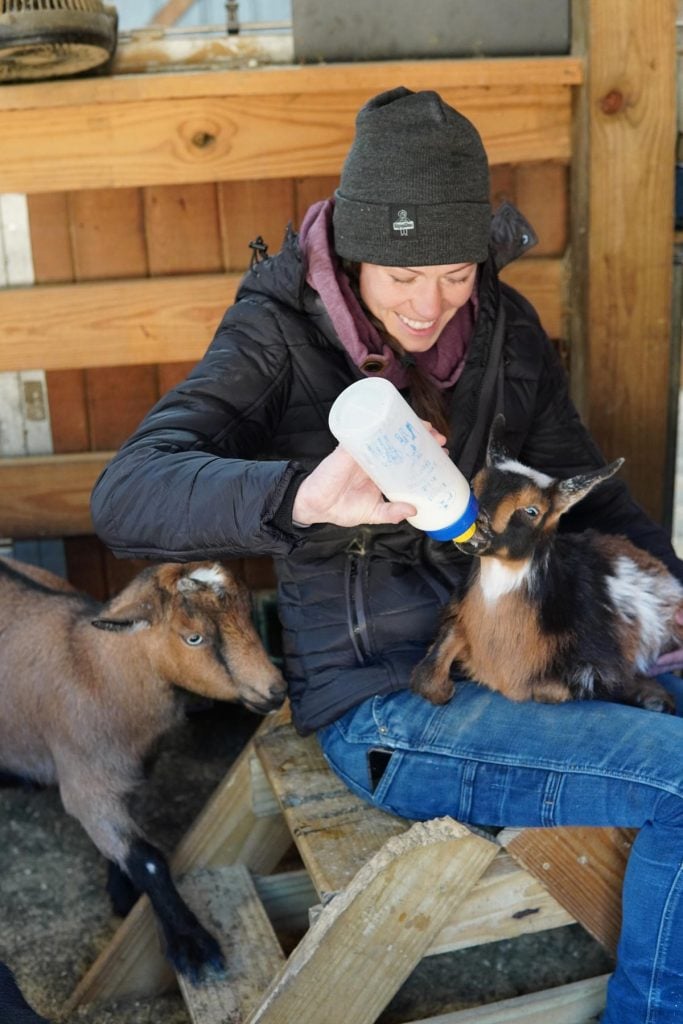
Three Ways for Better Tasting Goat’s Milk
Anne shares her top three tips for the best tasting goat’s milk.
- No bucks on the property – Anne doesn’t keep any male goats on the property because they tend to be very stinky with their pheromones, which can get into the flavor of your milk.
- Cleanliness, cleanliness, cleanliness – Anne says “from teat to table” there is no room for bacteria to get into the product. This includes a clean barn and bedding, a clean milking stanchion, sterilized implements, and double-filtered milk that’s stored in clean glass jars.
- Feed – Anne loves Chaffhaye and natural foraging practices. Her goats always get a Chaffhaye snack while during milking which makes them happy willing participants in the daily ritual.
Frequently Asked Questions
How Much Milk Do Goats Produce?
Just as you can have a high energy or mild-tempered breed, you can also have a unique animal that’s on the higher or lower end of the average milk production.
There are many factors that go into how much milk a goat will produce each day. The breed, the genetics, the feed, and where they are in their lactation cycle (is it the first or third time they’ve had babies?) will all be determining factors for how much milk.
- Nigerian Dwarf – at least a quart per milking. Anne allows her kids to nurse during the day so she only milks once per day. If the kids are not nursing, expect half a gallon of milk each day. Their butterfat is among the highest at 14%.
- Nubian – on average you can expect about a gallon of milk per day. They, like the Nigerian Dwarf, also have some of the highest butterfat content.
- Saanen – this is a slightly larger breed of goat that can produce upwards of 2-3 gallons, but on average 1.5 gallons per day. Their butterfat content is quite low.
- Alpine – certain animals have been known to produce upwards of 2-3 gallons per day, but the average is around one gallon of milk per day.
- LaMancha – this breed produces, on average, one to two gallons of milk per day at that lower 4% butterfat.
How Much Cream Do Goats Produce?
As we’ve discussed, the butterfat (or cream) percentage can vary widely between breeds. It depends greatly on the feed and their lactation cycle as well.
Anne shares that with her Nigerian Dwarf goats, she can get about a quart of cream from a half-gallon of milk. The difference between goat’s milk and cow’s milk is that it’s naturally homogenized so as the milk cools you won’t see that distinct line where the milk and cream separate.
The cream will eventually rise, and the milk will settle, but when you go to scoop the cream off the top of the goat’s milk it’ll be closer to a half and half than a true heavy cream. If you want true heavy cream, you’ll need to get a cream separator.

What Can I Make With Goat’s Milk?
Anne says you can make anything you would make from cow’s milk or heavy cream with goat’s milk or cream. She successfully makes homemade butter, ice cream (check out Anne’s coffee ice cream recipe here), cheese, yogurt, and many more products. In fact, Anne has a dairy course where she will teach you, step-by-step, how to make dairy products.
For a realistic view of how making homemade dairy products can fit into your lifestyle, check out how Carolyn makes a week’s worth of dairy products in two hours.
How to Sell Goat Milk Products
Many people think about raising dairy animals with the idea that they’ll sell some of the product to help offset the cost of raising them. This can be a fabulous idea, but our advice is to get a good system down first. Don’t plan on selling any products until you have a reliable routine.
After that, you’ll need to check into your state’s laws about selling raw milk for human consumption as many states prohibit this.
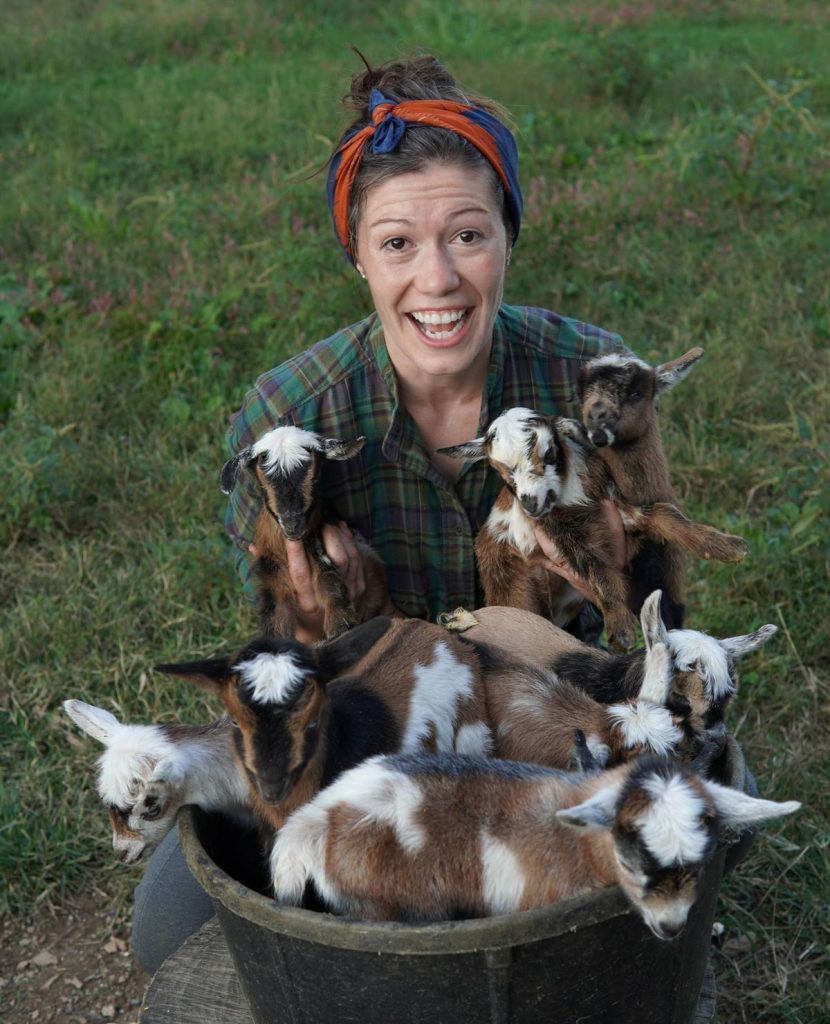
Where to Find Anne
You can find Anne anywhere on the internet with a quick search of “Anne of All Trades”! Below we’ll list some of the resources she shared in this episode of the Pantry Chat.
- Anne’s website
- Anne on Facebook
- Find Anne on Instagram
- Anne on YouTube
- Raw Milk Course
- Anne’s composting system
More Posts You May Enjoy
- How to Raise a Year’s Worth of Meat
- Mineral Supplements for Goats
- What to Do With Raw Milk
- Clabbered Milk (And the Anatomy of Raw Milk)
- Making Homemade Dairy Products Practical
- How to Freeze Milk (Or Freeze-Dry Milk)
- Homemade Cultured Soft Herbed Cheese
Josh: Hey, you guys, this is Josh with home state family, and welcome to this episode of the pantry chats, food for thought, as you can see, I'm not with Carolyn today. I am hanging out with Anne of all trades.
Anne: Hello, and thanks for having me.
Josh: Yeah.
Anne: Glad to be sitting here with you, here in Tennessee.
Josh: Absolutely. I am here at Anne's place in the shop. And if you guys have been following along, you've probably caught that we're doing some filming.
Anne: Yep.
Josh: We've got some really neat stuff going on with Anne and other creators that's coming up this fall. So we're not ready to tell you about it yet, but Anne's involved and it's got something to do with milk goats, and it's going to be really, really cool. We just had a blast filming.
Anne: Yes.
Josh: Actually. We've been working hard haven't we?
Anne: It's been a long couple days, but literally there's nothing that I love more than teaching and hanging out and getting to know new friends that are doing similar things, over a shared enjoyment of the stuff that we do. This is the stuff of life getting to hang out and talk about it.
Josh: Oh yeah.
Anne: Honestly.
Josh: And it's always fun to see what somebody else that's talking about things, that's living and is doing, and share stories and swap what's going on. And so today after we get through a little chit chat and one of your questions, we're going to be talking milk goats, because I actually know nothing about milk goats.
Anne: Well, you should know something now.
Josh: Well, okay. Now I do, I've learned a few things over the last few days and you guys saw Abigail. My daughter was here with us and it sounds like now we might be getting milk goats after hanging out with you for three days.
Anne: I mean, I tried my best to talk her out of it, but I think that she's
Josh: She's,
Anne: She's determined.
Josh: She's pretty determined. So I'm glad we've been getting an education. And we're going to talk about that a little bit and share some of Anne's expertise because she knows milk goats inside and out. But first Anne, we always do what's called little chit chat.
Anne: Yeah.
Josh: And then just kind of check in with what's going on with daily life. So
Anne: Great.
Josh: Besides this last week of filming, what's up with you, what's going on here on the farm in Tennessee this time of year and just what are you up to?
Anne: Well, it's Spring time on the farm here. Just like it is pretty much everywhere else. So we're in baby season. I've just had a new baby calf for my milk cow. So we started milking the milk cow, putting the garden in and I'm actually doing a large scale building project here. I'm building a school, where we'll teach disappearing life skills. And so that's pretty much anytime I'm not on the computer or milking goats or milking cows, that's what I'm doing.
Josh: Very cool. So you're going to have an Anne of all trades onsite I school physically teaching skills.
Anne: Yep. Yeah. It's called the School of All Trades.
Josh: Okay.
Anne: And we will be teaching woodworking, blacksmithing, some garden and homestead-y things, but we're more focused on the craftsmanship side of things.
Josh: Nice.
Anne: Yeah.
Josh: Very cool. Well, that's an important set. Like we talk a lot and of course at Homesteading family we're really focused on food. And a lot of what we're talking about is around food production from growing, raising, preserving, cooking, but that's just one part of what we do, right?
Anne: Yeah.
Josh: Where we live and the skills of knowing how to do woodworking, know how fix things, knowing how to work metal a little bit.
Anne: Yeah.
Josh: Weld or blacksmith. All of that stuff is super crucial.
Anne: Yeah.
Josh: To the lives that we're trying to live.
Anne: Oh yeah. It's so funny, man. You think, okay, I'm going to put in a few raise beds, get some chickens, but the skills that you have to learn, start to really compound. And honestly, one of my favorite books, it's called Range, and it talks about the value of having a whole bunch of different skills from different disciplines.
Josh: mm-hmm.
Anne: And the more that we've integrated farm life into our daily life, just the more things I've had to learn how to do. Like, who would've thought I would've ever had to learn how to fix my tractor, or you know how to manage a compost pile or anything else just like you get some chickens and it's all downhill from there.
Josh: Man, and you hear you guys, you can do this. Anne's coming from the place where she grew up into, I believe the kind of tech corporate world, right?
Anne: Yeah.
Josh: Doing marketing?
Anne: Yeah.
Josh: In the high rise.
Anne: Yep.
Josh: And look at what you're doing now. And you're fixing tractors. And-
Anne: Yeah, I mean 10 years ago I had never, I always say this in my own videos, 10 years ago, I picked up my first tool and planted my first seed. Even growing up, we never had a family dog or cat. And so now living on acreage and milking cows and assisting with goat births, like if you told me I was going to be doing what I'm doing now, 10 years ago, while I was living in Beijing, I would've laughed in your face.
Josh: Like yeah right.
Anne: Yeah.
Josh: And yet, here you are. And it's just a Testament to, you know, homesteading is not just a thing you go and do and settle land in this legal term anymore. It's a mindset, right?
Anne: Yeah.
Josh: And you can start wherever you're at. And that's something we really try to encourage people about is you don't have to get to five acres, or an acre, or 40 acres first. You start learning skills right now where you are, especially today in these times. That's so, so important.
Anne: Yeah. I mean our first farm was on our quarter acre plot in the middle of Seattle. I had chickens, it turns out they were illegal at the time, but now-
Josh: Illegal chickens.
Anne: Yeah. Illegal chickens. And I dug up our whole backyard and then I ended up digging our whole front yard and I was growing almost everything that we ate just in the middle of the city there. Then we ended up getting an acre also in the city.
Josh: Okay.
Anne: And I was able to expand that a little bit. But yeah, wherever you're at my favorite thing, my grandpa always said he was like, use what you've got to get what you need. And so if what you need is to have a little bit more confidence in yourself and your skills and your abilities, if you want to have a little more security, and self-reliance... I've literally seen people with full farms on their balconies in Taiwan. There's people who are raising chickens and things in every single pot and pan just has things growing in it. And you can start wherever you're at.
Josh: Oh, fantastic. Cool. Well, glad you're here. Glad you're doing what you're doing. Let's jump into a question of the day.
Anne: Please.
Josh: And then we'll talk milk goats. Okay, so earn Ernest Harris 9-0-82. I think this was from an IG post says, I'm having an issue composting, not enough material. So I was wondering, could adding fish emulsion to the heat help? Well, there's a couple things to talk about right off the bat. If you don't have enough material and you're just talking general mass, you've obviously got to add a whole bunch of material and fish emulsion is not a lot of material in and of itself. It has a purpose, but you need at least a compost pile that's about three foot by three foot by three foot tall. Right?
Anne: Yeah.
Josh: That's the minimum to really successfully compost.
Anne: Yeah.
Josh: I don't know about you, I've tried a couple of the turning bands and different things. And I don't know. I know they kind of work for some people, but that's not really seriously composting if you're trying to grow your own food and get something going.
Anne: Yeah. I mean, we do like the simplest thing you could possibly do. I have actually two different things here on the farm. I have one just pile that I turn and add things to, but I also have a three bin system that is set up. It's just pallets that I screwed together. It took about an afternoon to put it together and now we can make literally more compost than we could ever use here, just in a three bin system like that. But you've got to have three feet by three feet by three feet is a great thing because otherwise it's not going to get hot enough. There's not going to be enough weight on top. And yeah. Fish emulsion is a great thing to add to the garden. It's actually-
Josh: Well, it's high nitrogen.
Anne: Yeah.
Josh: So it's a good nitrogen component, right?
Anne: Yeah.
Josh: But it's not going to add a lot of mass if you're just lacking material to get that pile large enough to heat up. Yeah. Fish emulsion isn't going to do it, in and of itself.
Anne: Yeah. But it is very likely that you have on hand, or you could easily scrounge up what you would need to add that extra mass. I mean, shredded paper, cardboard. If you're shopping on Amazon,
Josh: Yeah.
Anne: Like you've got all-
Josh: Wood chips, wood shavings, straw, as long as you can get it clean. That's the big challenge with straw today. It's getting clean and not having any chemicals in it. Leaves from the trees in the Fall.
Anne: Yep.
Josh: Right now, if you get them from trees that are cut live, they're going to be more of a green material and nitrogen material. And you're talking about fish emulsion so I'm wondering if your concern is not more nitrogen, more than just more material in general. And fish emulsion is a good nitrogen source, but I would say it's kind of an expensive one. Fish emulsion is not cheap. We could also go down kind of the trail of is organic or not? Where did the fish come from?
Anne: Yeah.
Josh: You know, some of that. And so I'd say you want to make it organic. But if you're just needing nitrogen, fish emulsion can be cool, but there's a lot of other great things. Coffee grounds, we were talking about. Anne and I love our coffee and she makes a mean espresso.
Anne: Well shoot.
Josh: It is, oh excuse me, espresso, sorry. Before somebody corrects me.
Anne: That's okay.
Josh: But really, really good. So coffee grounds, grass clippings. Everybody's grass is starting to grow this time of year. That's a great source of both material and nitrogen.
Anne: Yep.
Josh: Yeah. So use the fish emulsion sparingly. Save it for maybe some amendments and save the cost and find some of these other sources for nitrogen and just materials in general.
Anne: Yeah. And one last little note on compost in general, is that for your compost to really work, you need three parts carbon for one part nitrogen. And we often call them greens and browns with your three parts carbon. That can be anything that is anything brown, honestly. Anything straw,
Josh: Right.
Anne: Or cardboard, or paper, anything like that. And then you need to put only one part nitrogen to that. So if you have coffee grounds, add some cardboard or some paper, or some sawdust, or whatever. Or, and I actually just wanted to say too, if you need coffee grounds and you're not a coffee drinker, like we, are almost every coffee shop gives them away for free Starbucks even has a little dumping program where you can actually ask them, Hey, can I have a bag of coffee grounds? They'll give it to you for free.
Josh: Nice.
Anne: Yeah.
Josh: Very cool.
Anne: And that's like, that's enough nitrogen to do an entire three by three [crosstalk 00:09:35] .
Josh: Yeah. Yeah. That's a lot. And I want to clarify because when she says three to one, that's actually in volume.
Anne: Yeah.
Josh: So when you're mixing volume three to one, I do a two to one generally,
Anne: Oh yeah.
Josh: But right in there somewhere. And so just don't confuse that. Cause when you read about it, what you're going to see is 30 to one is the ratio of carbon to nitrogen. But that's in particles. That's a little bit different.
Anne: Yeah.
Josh: When we're mixing and we're just out on the farm and you're measuring with a five gallon bucket or a shovel bucket, then that's that three to one you're talking about.
Anne: Or I mean, you say you do two to one? Two buckets of carbon?
Josh: I do two. Yeah. Two one in general.
Anne: Yeah.
Josh: Yeah. And that gets it in there and gets you close enough. And then kind of from there, it's like, you want to go with a thermal compost or?
Anne: Well then you could really start-
Josh: Right then you're getting dialed in.
Anne: Yes.
Josh: Well cool. Good on the compost. So let's dive into raising milk goats. And we've been talking about milk goats all week. So I hope you don't mind talking about them just a little bit longer.
Anne: I mean, you got to share that good information. I think goats have a bit of a steep learning curve. So anything that I can do to help make that learning curve a little bit smoother.
Josh: Very cool.
Anne: I'm happy to do it.
Josh: That's good. Because goats are a great entry point for dairy animals and a lot of you know us, we've got a large family, dairy goats just aren't going to meet our needs really.
Anne: Yeah.
Josh: And Carol and I did dairy goats once for about, well they weren't even dairy goats, they were just goats, for about three days.
Anne: Yeah.
Josh: And they got into everything.
Anne: Yep. As they do.
Josh: You're right. And so they didn't last very long with us, but they have a great purpose in the small holding homestead. And even in the large one depending on what you're doing. So we've got some questions here that people ask us that our team came up with and that I know people are interested in, and one of the first ones is just, what are the best breeds for milk goats? What are you using? What do you like? But then I know there's a little bigger discussion as far as helping somebody choose, because it's really not what's the best breed. It's, what's the best breed for you.
Anne: Yeah. And honestly, almost all of this home steading information is not what's best. It's what's best for you in your situation because pretty much anything is- my mom always says flexible, adaptable, and out of control.
Josh: Yep.
Anne: But yeah, so I have Nigerian Dwarf Goats. Those are the ones that I chose because A. I think that they're really cute. So that's obviously a huge importance for me. As a photographer, I'm constantly taking pictures and things. So I wanted that. But far more importantly, for actual homesteading reasons, they have the highest fat content in their milk.
Josh: Nice.
Anne: So I think the only other domesticated- well, they're not domesticated. But the only other animal that has that high of fat concentration are polar bears. So Nigerian Dwarf Goats, they have about a 14 percent butter fat content.
Josh: I think it would be hard to keep a polar bear.
Anne: Yeah. A little bit harder.
Josh: Just saying.
Anne: Yeah. But Nigerian dwarfs, they have a 14% butter fat content in their milk. Which, whole milk that you get from the grocery store from a cow is 4%. So imagine 14%. It's pretty-
Josh: And that's value right there is what that represents. That's high value.
Anne: Yeah. It's really good. And so that's the reason that I wanted Nigerian Dwarves is because they are really small. They are really cute, but they produce a phenomenal quality milk and then if managed right. That is also the best tasting milk I've ever had. I mean, everyone that's come to my house, I do a side by side comparison. You want to taste my cow milk? Do you want to taste my goat milk? And everyone says goat milk's the best.
Josh: Yep. Abigail today said it was better than the cow milk.
Anne: I know I was so pleased by that.
Josh: Very cool. Okay. So Nigerians are one. That's what you've settled on. That works well for you, but what are some other options as far as dairy breeds?
Anne: Yeah. If you're looking for higher production... So because Nigerians Dwarves are so small, a good Nigerian Dwarf will produce about a quart of milk a day. I had one Nigerian DF that was kind of like a unicorn, but she would produce a gallon a day and it was the best milk. But she was the worst goat. So we've moved to other goats that produce a little bit less, but are still quality animals. So we get about a quart a day from Nigerian Dwarfs. If you're looking for more volume, I would suggest going with a Nubian. A Nubian is a slightly bigger goat.
Josh: Okay.
Anne: But they're much higher producer. The thing that you sacrifice there though, is the fat content. So Nubian milk has a much lower fat content by ratio-
Josh: Like half? 7%? 10%?
Anne: I think it's even less than that.
Josh: Oh wow.
Anne: I don't know a ton about it because I've never kept Nubians myself, but other dairy breeds, Alpine are good. Saanens are good. But really I would say there's literally so many breeds. I had an Angora goat that I wanted for her fiber, but then I ended up milking her as well. So basically, any goat can produce the things that you need. It's just really, what's available locally to you. What breed is going to make the most sense for the space that you have. And also you have to think about not just how much fenced area do you have, how big your barn? How many animals can you actually fit there? Because a Nubian goat is over twice the size of a Nigerian Dwarf. So I would in our little barn situation here, I wouldn't feel comfortable having 11 Nubian in there by any means. Yeah.
Josh: Yeah. So space is a little bit of an issue there.
Anne: Yeah.
Josh: Thinking about what works for you on your spot.
Anne: Yep.
Josh: You made a good point there about what you can get. And sometimes we get very, very hung up on the breeds and I'm actually reading through Joel Salatin's Polyface Micro right now.
Anne: Yeah.
Josh: And he's just always got so many words of wisdom, and that's one of the things he was talking about. About animals in general is getting off the boat about always having to have this particular specialty breed. That's nice. And, sometimes there's a good reason for that and there's a fit, but sometimes, especially when you're trying to get started, what do you have access to? You don't want to be driving 1500 miles-
Anne: Yeah.
Josh: To go buy a specialty $1,500 goat.Eespecially if you've never had goats, that's down the road 10 years where you're maybe then breeding program and those stuff, but you want to get started. So make sure it's accessible.
Anne: Accessibility is hugely important. I mean, even beyond that, because to be able to have milk, you have to have babies. And so then to be able to have babies, you have to have access to other goats to breed to. So if you're not going to keep a buck or a male goat on your own property, you need to have someone close enough nearby that you can go visit or have your goats visit or you need to learn AI or you need to get in with a vet that can do AI. And a lot of vets won't do AI on goats. So there's so many things to consider, but availability locally is hugely important.
Josh: Yeah. Cool. Okay. So another question are there breeds that work for both milk and meat goats? And this is a huge topic because a lot of people getting started wanted to the most they can with what they have. Kind of like chickens, and go breed chickens, right?
Anne: Yeah.
Josh: And there's always pros and cons to going with dual purpose.
Anne: Yeah.
Josh: But what are your thoughts on that? And do you have some suggestions for dual purpose breeds?
Anne: Yeah. I mean, my suggestion for dual purpose would actually be the Nubian because they are larger. So if you're going to think about harvesting something for meat, you want to there to be enough meat to make it worth it.
Josh: Okay.
Anne: I actually do have friends that raise Nigerian Dwarves and they eat their Nigerian Dwarves too. And they say it's great meat. It's just, there's a lot less meat.
Josh: Small.
Anne: On a smaller animal than there would be on a larger one. So Nubians are great. Boer goats are the best for meat.
Josh: Boer goats?
Anne: Yeah. It's B O E R Boer Goats.
Josh: Yep. Yep. Okay.
Anne: Those are great for meat. So you might even consider making yourself an inexpensive little mut by breeding a Boer and a Nubian together, and then getting those meat and dairy genetics.
Josh: Yeah. See, I think that's a nice strategy. Get the dairy goats that you want.
Anne: Yep.
Josh: And as long as the size is compatible, get, or find somebody that has-
Anne: Yep.
Josh: A, oh gosh, I got stuck.
Anne: A Boer goat.
Josh: Yeah.
Anne: Yeah. Or somebody who has the,
Josh: Has a buck. Yeah. Has a Boer buck, is what I was trying to say.
Anne: Yes.
Josh: And cross breed them. Then you're getting a little hybrid vigor as well.
Anne: Yep, exactly.
Josh: In the growth there.
Anne: Yeah.
Josh: Yeah. Just don't plan to keep those babies for milking probably.
Anne: Yeah. My buddy, Jason has Boer goats that they raised for me in Texas, and they milk them as well. So I mean they're-
Josh: There you go.
Anne: Any animal that has babies produces milk.
Josh: There you go. Cool. All right. Can you raise just one milk goat at a time or is it better to have multiple, or more than one?
Anne: Yeah. So goats are herd animals and it is actually extremely unkind to the animal and probably to yourself to have a herd animal and only have one of them. So I always recommend that people have at least two goats. That doesn't necessarily mean that you need to have two high dollar, high value milking goats, or that you have to milk both of them. A great strategy with that is to get two female goats, and to milk one six months a year and then milk the other one six once a year. And then you've got a full year supply of milk. You can honestly have as many goats as you want, but the absolute bare minimum would be two because goats are herd animals that are also prey animals. So you're going to have a very unsettled animal if you try to just raise a goat by itself.
Josh: He's going to be miserable.
Anne: Yeah.
Josh: Yeah, yeah. You really need to think about the mental health of that animal. And if that animal's not comfortable and happy.
Anne: Yep.
Josh: You're not going to be comfortable and happy.
Anne: And goats especially, we talked so much this week about the psychology of goats, but you want your goats to be well settled. And the other thing too, is your life is going to be miserable even if you just keep it as a pet, because that goat is going to be so attached to you. And so desperate for you and needy for you. It's not like a dog. You can't just hope it sits on the couch on the day. Like while you're at work all day.
Josh: Right.
Anne: Goats need buddies. Yeah.
Josh: Yeah. I would be scared to come home if you left that lone goat in the house to hang out on the couch. Okay. So how much milk can a person expect from goat a day?
Anne: Yeah. We talked a little bit about that. It really depends with every goat, the breed, the genetics, where they are in their lactation cycle. Is this the first time they've had babies or is it the third time that they've had babies?
Josh: Okay.
Anne: Because the first time, they're going to have a little less milk, next time they're going to have a little more by the third lactation cycle, they tend to be kind of at their peak. But like I said, for Nigerian Dwarves, I expect at least a quart per milking. And so, because I have my kids also nursing during the day, I only milk once a day, but if they're doing twice daily milking that's then a half gallon, so that's not too bad at all. But I always like to think, is this worth it? If it's not at least a quart of milk a day, to me, it's not worth all the dishes and the chore time and everything else to maintain an animal. So I would say, look for an animal where you can get at least a quart a day. And beyond that, it really just matters. Like, okay, what are they eating? What breed is it?
Josh: Right.
Anne: What are the genetics like? Is it a first time timer or is it a 10th timer?
Josh: Right. And then you just got to couple that with what you think your needs are going to be. Which kind of runs into the cream.
Anne: Yep.
Josh: And I didn't know, for a long time. And I know a lot of people didn't realize that you can actually separate the cream.
Anne: Oh yeah.
Josh: Of goat's milk.
Anne: Yeah.
Josh: And make other products a little bit. So tell us a little bit like maybe per gallon's a good gauge, like per gallon, about how much in volume, of cream can you get?
Anne: Yeah.
Josh: And you know, a little bit about separating and how you go about that and then what you can do with that cream.
Anne: Great. So in a, I'm actually going to say half gallon, because these are the ones that I have, but a half gallon jug is about like this by this. And When you let the cream actually rise to the top, you're actually going to be about- with our goats at least, you're going to be about half and half there.
Josh: Really. You're going to get about a quart?
Anne: Yeah.
Of cream?
Josh: About that, however-
Anne: Seriously,
Josh: Its not-
I'm warming up to goats a little bit.
Anne: It's so great. And just to debunk that myth, like you can make goat butter. Goat butter is delicious and delightful. You can make ice cream. Literally we're talking the fattiest, creamiest, best, best stuff. I really, really love-
Josh: Wow.
Anne: Love that goat stuff. But one little funny thing about goats is that you've heard about pasteurized and unpasteurized homogenization.
Josh: Yep.
Anne: Everything. Goats actually naturally homogenize their own milk. So if you put a gallon of cow milk on the counter, that cream is going to rise and it's going to be like a very visible line and you can literally just,
Josh: It's very clear, very separated.
Anne: But with the goat milk, while you can see it in the jar as a very clear line. It doesn't quite scoop off just like just that easily. So I end up really more, if I'm just skimming the cream with a spoon, I end up with something more the consistency of like half and half.
Josh: Okay.
Anne: And so if I really, really need that heavy cream, I have to use a cream separator.
Josh: Okay.
Anne: And you can get micro dairy cream separators. I have one. It's not my favorite thing to use just because it's kind of a pain in the butt to wash and set up all the things just for a small amount of milk. But when you do set it up, you can process 20 or 30 gallons of milk. I often will freeze the milk and then just process it all at once. So you can process all that milk at once and then, it makes it worth that time investment to get that cream separator out and to do that. But you can still, even with that half and half like stuff, you can still make ice cream with that. It's still going to freeze great. You can still make butter with it. You're just going to end up with more-
Josh: Butter,
Anne: Butter milk.
Josh: Right?
Anne: Yeah. Okay. And so, everything that you can do with cow milk, you can do with goat milk. In fact, my mozzarella cheese, from the goats is so much better than my mozzarella cheese with the cow milk. And that's a very, very easy thing to learn. So I make pizza every Sunday. We always use goat milk mozzarella on it. And it is literally the best thing. And the easiest thing to make. I mean, you're talking a 30 minute time investment. It's like a three hour project, but you're just there touching the cheese for about 30 minutes.
Josh: Abigail Anne's warming me up here because she's hitting some of our buttons. We love butter.
Anne: Uh-oh.
Josh: We love mozzarella. We make pizza every Friday, homemade pizza.
Anne: There you go.
Josh: And so, having some options is great.
Anne: Yeah. I had a whole line of goat milk products. I had my gutter, although that doesn't, it's not the most appetizing sounding name. I had-
Josh: Your gutter.
Anne: I had my Gogurt.
Josh: Okay.
Anne: But apparently Gogurt has already been taken. So I'm just kind of open.
Josh: I've definitely heard that term. Yeah.
Anne: Gogurt's like the little slurpable kid's yogurt.
Josh: Oh, that's right. Yeah. They're in those little packets.
Anne: So then I was like, well maybe I call it goat gurt. But then we're getting out of control here.
Josh: Goat gurt, I don't know. I like goat gurt. I like it. You better claim that one.
Anne: Yeah.
Josh: Okay.
Anne: TM.
Josh: That's right. Let's see here. What are some basic supplies to get started milking goats? And so we've been talking all about all this this week. So trying to do the quick rundown, just maybe not so much supplies and phrase it, like what are some of the just key things you need to know. If you're thinking before you get goats, and guys don't do what we've done. I'm sure Anne has done, and most of us that are up here sharing our knowledge, have done. Don't go out and get the goat without thinking about your infrastructure and everything.
Anne: Oh yeah.
Josh: First. Learn from some people that have already done it, have done it hard way and done it wrong.
Anne: Yes.
Josh: You know, get prepared, get set up. So Anne, what are some things people need to know before they get their goats?
Anne: Yeah. Before you bring your... Well, I think we've all gone to tractor supply and come home with some baby chicks and we're like, we'll build the coop later. We do not do that with goats.
Josh: I did it with a milk cow.
Anne: All right. I mean, let's be honest. He has heard this story already, but I did that with my first milk goat. I brought her home before I had anything set up. In fact, I'd never milked an animal before. I'd never even had a dog before. And I thought it was a good idea to get a goat that I would need to milk right away. And I learned the very, very hard way that is not the way you should go about getting any livestock animal.
Josh: Yep.
Anne: But all that to say, I learned those hard lessons, so you don't have to. So the number one most important thing that you need for goats is, let's think about any living being, you need food, water, shelter.
Josh: Yep.
Anne: Access to good food access to clean water. And at least a three walled shelter. If you're living in a climate that has extreme temperatures, you're going to need a barn that shuts and you're going to need a way to keep them cool if it's hot and warm, if it's cold. But beyond that, the thing that you absolutely need for goats is a good fence. Goats are massive escape artists. They are not intentionally mischievous. But I do think that it is kind of interesting that goats are often personified as the devil for good reason, because they are just being themselves. They are very itchy creatures. They like to scratch themselves on things which often will open up a hole in the fence. They like to nibble on things, which is a great way for them to learn how to open your gate latches, all of these things. So you need to have an absolute bulletproof way to contain your goats before you ever bring them home. Otherwise, they're going to get into... I had to go eat the wires out of my tractor.
I have had to replace the microphone cable for my YouTube videos about three times. And it's not cheap because one of my goats just loves to eat that cable right out of my pocket. I have had a goat nearly get hit by a passing car because she got out and was out there. Had goats cause about $1,500 worth of damage to a plumbing project that I was doing.
Josh: Ouch!
Anne: They came in and ate my entire garden once, which was not great. So, having a good fence is your probably number one priority. And that is not just like the actual structure of it, but thinking too goats can jump. They climb on things. So I put one time, a little play structure, a little too close to my fence line and they just jumped right on top of the play structure, and jumped right over the fence, got right into the garden. So you just-
Josh: Reminds me of some of the old cartoons, but all humor is built on some truth, right?
Anne: Yeah, exactly. We cried about it first so that you can laugh about it later, but yeah, so that's the biggest thing is like having a solid plan for how you're going to contain them. They are prey animals too. So for them to feel safe and secure and all those things, they need to know that they are actually safe and secure. So that means you also can't just have a little short fence that a dog could jump over. A lot of people have goats in the city, which is great. There's less natural predators there. But if you're out in a rural area, like we are, then you've got to think about, well, how am I going to keep it safe from-
Josh: How are you going to protect them?
Anne: a Cougar or a pack of coyotes. And there's lots of options there, but we could talk about this all day, but yeah, that's the best thing. And then the other thing is if you're going to milk your goat, you need to have a milking stand and actually have a whole YouTube video about that on my YouTube channel. It's good. You can look me up Anne of All Trades, and you can see goat milking stands and see how to build them. It's a pallet cut in half with a little hinge on the front. So it's nothing too fancy.
Josh: Yeah. You don't have to be elaborate for some of these things. I mean, if probably if you're going to put money in infrastructure, it's going to be that fencing where you're going to really do it right. Because there's so many things that you can DIY.
Anne: Oh yeah. I've made everything that I needed for my goats. But I spent $4,000 building a solid goat pen, before I ever stepped foot on this piece of property. Because I knew when we moved in and we pulled up in that trailer, I needed somewhere that I could put my goats and trust that they'd still be there in the morning.
Josh: And I think that's where a lot of the frustration for people comes from is the fencing issues. Is them getting out because once they get out, they're curious, they're mischievous, they like to get into things. And that's where all the horror stories come from.
Anne: Yeah.
Josh: So if you contain them well, a lot of the rest of it works itself out.
Anne: Yeah, absolutely.
Josh: Cool. Let's see here, tips, if you want to sell your goats milk. So I'd say that's a little advanced you better just get to hanging out with goats a few years first, but what's a-
Anne: Oh yeah. Tips for selling goat milk. Well, here's the thing I actually am not, unless you're really doing it on a pretty big scale, which to be honest, I'm doing it on a pretty big scale already. And there's really not that much leftover. Cause if you're talking about a quart a day, like my biggest sale product is yogurt. And that's just because it was a way for me to divide a gallon into four quarts that are saleable for the same price as the gallon. But I will also say too, in a lot of places, there are laws about selling raw milk. So you do want to watch out for that.
Josh: Yeah.
Anne: There's some ways around those things, but really, I would say that the way that you sell your goats milk is the same way that you sell anything else. Tell a story, find, find your niche audience, the people that actually need that thing. And then tell them how your product is going to change their life and make their lives better.
Josh: Absolutely. But I would add if you're getting started, don't think that you're going to go get goats and go right into- and this is the same really with any animal go right into an enterprise, a money making enterprise. You need to cut your teeth so to speak, you need to get out there, get familiar with the animal and no matter what any of us can share with you, you still got to go have experiences, right? And so don't get goats because you're going to start a business, get goats, because you're interested in having goats. You want the goats man milk for a part of your provision and learn the ins and out and spend a few years getting to know them.
Anne: Yeah.
Josh: And know how to work with them, know how to care for the milk. If you're going to sell something like that, you really better know how you're caring for your milk.
Anne: Oh yeah.
Josh: And, and so that when you're handing it off to somebody else, eventually you're handing a product that you really know what you're doing. You stand behind.
Anne: Yeah.
Josh: And then through that, you'll be able to figure out a lot of these other things about going into business.
Anne: Yeah, just to echo what he said, even about just thinking about anything as a business, I think as homesteaders, we tend to be really entrepreneurial people. And a lot of us have a really hard time just doing a hobby, just to enjoy it or just to do anything thing to enjoy. Our mutual friend, Alyssa, that introduced,
Josh: Yeah.
Anne: We always talk about we don't know how to have a hobby. We only know how to start a business. But the thing about farming is that until you have enough experience, it is not a viable business plan. In fact I mean, even if you have enough, even if you have a cow, which I do, just one cow's worth of milk is not in and of itself a business.
Josh: Yeah. It's not a very-
Anne: We talk about the $63 tomato, the person who thought that they could plant a garden to save money.
Josh: Oh, right.
Anne: And yes, there are ways to do that. And if you want to learn more about business and entrepreneurship and farming and how those can go hand in hand, check out, Joel Saladin. You Can Farm is a great-
Josh: Yep.
Anne: Great resource for that. But, goats as a business, honestly, I make about 10 times what I make from milk selling babies. And for me, the babies are where the business is because I'm selling registered, pure bred goats, that have incredible genetics. But it's taken me eight years to build out a genetic line where I'm actually able to sell those babies for those prices, because I can actually stand behind that product. But even at that, it's not a money making endeavor. Considering all the other things that I have to do to maintain my goat herd, I'm lucky if I break even. And I've been doing this for a long time.
Josh: Okay. All right, let's see here. I think we got time for about one more, and you touched on this a little bit, but let's just go a little bit more, the difference between cows milk to goats milk. And you obviously, you're doing both, you've got a dairy cow, and you've got goats. And so what do you like better? And what's the difference? And I think probably what's wrapped up in here is a lot of goat milk is goaty.
Anne: Yeah.
Josh: You talked about your goat milk and how good it is. And it's very good, but that's not the common experience.
Anne: Yeah.
Josh: That's not what most people think of. And so maybe tell us a little bit about why that is, and how to make sure that you've got goat's milk that you're going to enjoy.
Anne: Yeah. Well, here's the thing, I don't really know. I love goat cheese. You ever gotten goat cheese from the store that like Cherve, you can dip it in crackers, put fruit on the top. I love goat cheese. That kind of goat cheese is exactly what I want in a cheese.
Josh: Yeah. Very flavorful.
Anne: But I do not want to drink a glass of goat cheese-tasting milk. And that's what most goat milk that most people have had tastes like that. It tastes like the way a male goat smells, like it's musky. And it's like-
Josh: So why is that? Tell us the reason. We were talking about that this week, and what's one of the main reasons why it does taste goaty, it tastes like a goat.
Anne: Most goat milk that comes from the grocery store, first of all, it's going to taste goaty because it's old. It took a long time to get from the goat onto the-
Josh: So as it ages...
Anne: The grocery store.
Josh: As it ages it naturally, even if you're doing it at home, as it ages, it does take on a stronger flavor compared to when it's fresh.
Anne: Yep, exactly. So we talked a little bit about raw milk, raw milk doesn't actually spoil, it just changes and taste and texture as it continues to age. And so goat milk is best when it's fresh. So if I'm just going to drink a nice cold glass of goat milk, I want it to be with about like less than a week old surely. It will keep as drinkable milk for about two weeks. If you are extremely cleanly in your milking practices. But ultimately there's kind of three ways that we make our goat milk taste good and not goaty. And the first one is I don't keep any bucks, any male goats on our property. They themselves are quite stinky. And anything that is really stinky is actually going to then lend itself, come into the flavor of your milk.
Josh: Yeah.
Anne: Male goats are constantly releasing pheromones, which then affect the hormone balance of the ladies around them. And so that affects the flavor of the milk. So no male goats, it's to be fresh. And then cleanliness, cleanliness, cleanliness. And so, because we're doing raw milk here, our milking practices start in keeping an immaculate barn. I want to make sure that from teat to table, There is no possibility for any kind of bacteria or harmful pathogen to come into contact with the milk. I clean the goat, as she comes up on the stand, but she should be pretty clean to start with because she's coming from a very clean barn. I'm fastidious with the way that I do my home milking process. And then all my implements are extremely clean.
I filter it and then refilter it and then it's stored in glass, and then it's consumed quickly. The other thing that can really affect it is your feed. But to be totally honest, the feed is kind of the last in those list of-
Josh: Okay.
Anne: Three and then four, if you think about the feed. But I feed chafe and natural forage and that's pretty much all that I need to just literally make the best tasting milk I can possibly have. And it really is, I have all my goat milk customers. They can never get enough. They're like, this is the best goat milk I've ever had. When can we get more? I'm like, sorry, I only have so many goats and so many hours in the day.
Josh: I'm thinking about getting goats just so that I can make your coffee ice cream.
Anne: Oh yeah. That stuff is so good.
Josh: Yeah. She's got a great video on coffee ice cream. Those are two of my favorite things in life to consume.
Anne: You put the two things that the Lord gave us together. They become so, so good, coffee and ice cream, they belong.
Josh: Very cool. Well Anne, it has been cool hanging out here with you. And I think this is just so informative folks, especially for our audience. Because we don't talk a lot about goats.
Anne: Yeah.
Josh: And I think if Abigail has it her way, you've definitely sold her on goats.
Anne: Yes. Well, here's the thing you said probably. And I don't know about you, but if my dad ever told me probably, that was a yes in my book.
Josh: Yeah.
Anne: So, I think you're in it. I think you're in it now.
Josh: I got a dad's heart. I'm just slow to commit.
Anne: Yeah, There you go.
Josh: So anyways, we're going to wrap up here, but tell people just for a minute, how they can find you, what resources you have out there so they can look you up and what you're doing. Anne is just so cool. She does Anne of All Trades. I mean, she's doing goats, she's doing dairy cows. She's composting out here. I love your composting system.
Anne: Thank you.
Josh: You've got a great video on that. Some of my videos, I've done some of the smaller scale and I'm really composting on a large scale. She's got a great like mid-range system going here, so that's worth checking out. And so yeah, just how can people check you out and find out what you're doing?
Anne: You can find me anywhere on the internet at Anne of all trades, it's A-N-N-E of all trades. It's a Jack of all trades, but a master of none. But what most people don't know, is the rest of that quote is better still than a master of one.
Josh: All right.
Anne: So I figured, if I'm going to try all the things I'm going to build up a skillset and I've brought a camera along so that I can share it all with you. So you can find me on my website, Anne of all trades. That'll take you to all my social media profiles as well. I have Instagram so you can see what's going on on a daily basis, YouTube. So you can find out what's going on a weekly basis. And then on my website, you can get my classes and courses. I have a raw milk course that you can find on my website so you can learn all the things that you can do with goat milk.
Josh: Very cool. Well, Anne, it's been great hanging with you.
Anne: Yeah, great time.
Josh: You guys, it's been great hanging with you and we will see you soon.
Anne: See you later.
Good bye.
Sign up to receive email updates
Enter your name and email address below and I'll send you periodic updates about the podcast.



